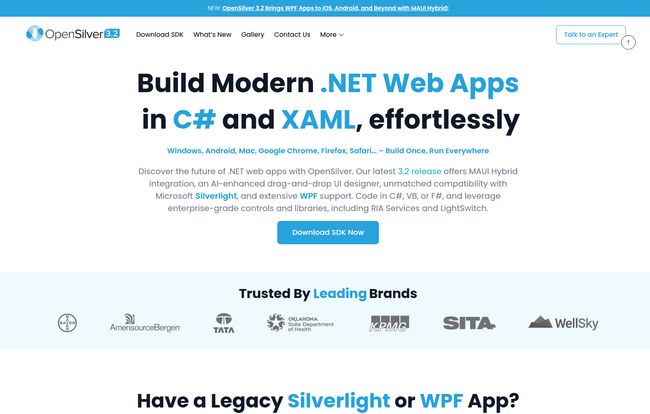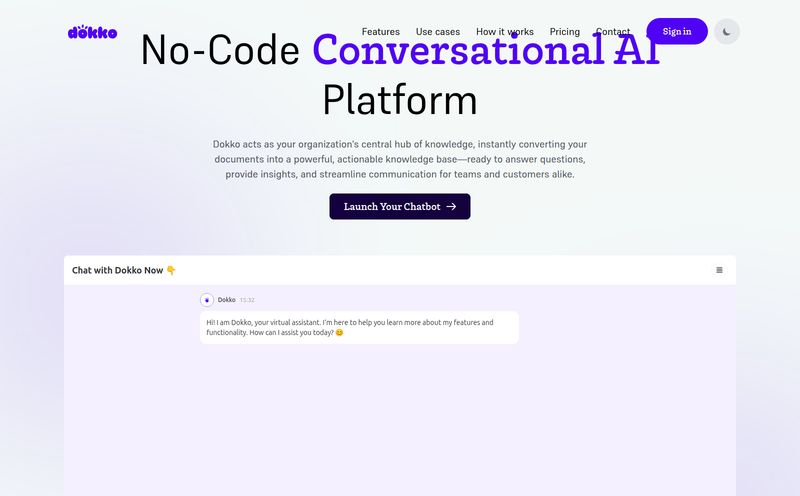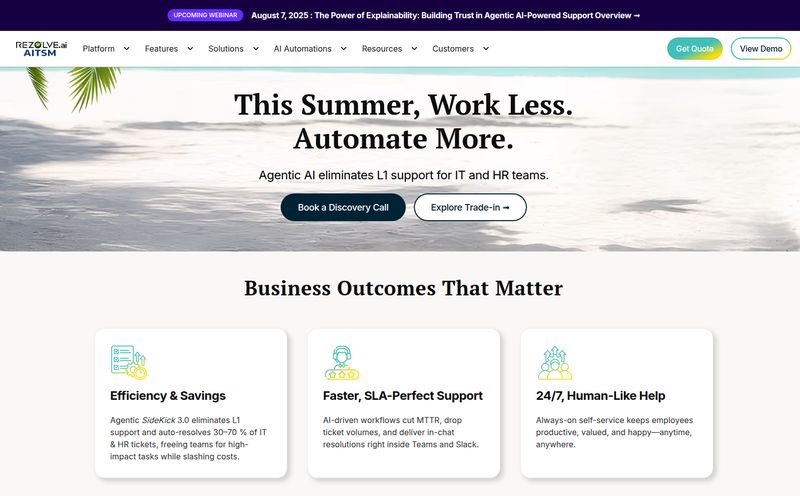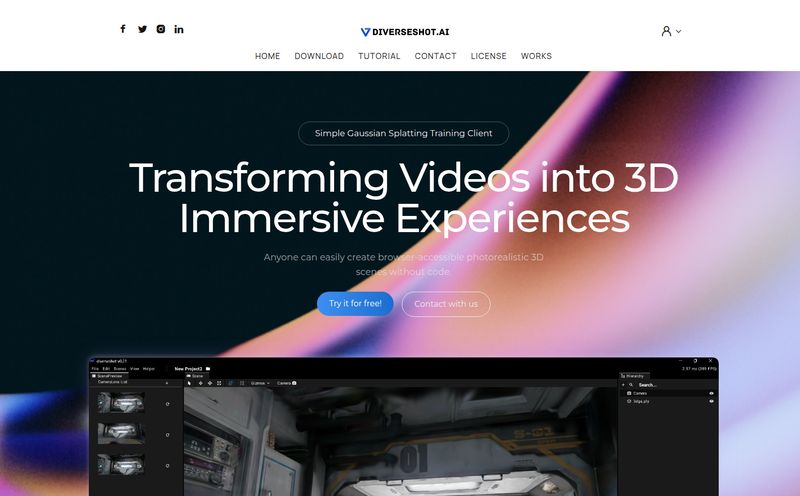Let’s take a little trip down memory lane. Remember the late 2000s? The internet was a different place. We were all excited about rich internet applications, and for a hot minute, Microsoft Silverlight was the talk of the town. It was powerful, it enabled incredible user experiences, and a lot of businesses—I mean a lot—invested heavily in building their core line-of-business applications on it. Then, the world shifted. Mobile took over, browsers declared war on plugins, and Silverlight… well, it was relegated to the tech hall of fame (or shame, depending on who you ask).
If you're a developer or a CTO at a company that went all-in on Silverlight or its desktop cousin, WPF, you know the pain. You’ve got this powerful, complex, business-critical application that works… but it’s trapped in a digital amber. The thought of a complete rewrite from scratch in a modern JavaScript framework is enough to give anyone night sweats. We're talking millions of dollars and years of work. So, you just… leave it. Hoping for the best.
But what if there was another way? A bridge from that legacy code to the modern, browser-agnostic web? That's the promise of OpenSilver. And I've been digging into it, because frankly, this is a problem I see crop up all the time in my consulting work. So, let’s talk about it. No fluff, no marketing-speak. Just a real look at whether this tool is the lifeline so many companies have been waiting for.
So, What Is OpenSilver, Exactly?
Think of OpenSilver as a de-extinction machine for your old .NET code. It's a free, open-source UI framework that takes your existing C# and XAML code from Silverlight and WPF applications and recompiles it to run on modern web standards. Specifically, it uses WebAssembly (Wasm), which allows code written in languages other than JavaScript to run natively in a web browser.
This is not an emulator. It's not a plugin. It’s a complete reimplementation of the Silverlight API that translates your application into something that browsers like Chrome, Firefox, and Safari can understand and execute today. Your app, which was once shackled to an obsolete plugin, can now run on Windows, macOS, Android, iOS… pretty much anything with a modern web browser. It's a pretty bold idea, and one that could be a game-changer for the right kind of project.

Visit OpenSilver
The Ghost of Plugins Past: Why This Even Matters
For some of the younger devs out there, it might be hard to grasp why this is such a big deal. The whole concept of a browser plugin feels ancient, right? But for a long time, it was how we got rich functionality on the web. Flash and Silverlight were kings. They allowed for complex animations, high-performance data grids, and desktop-like experiences long before HTML5 and JavaScript caught up.
The problem was the security vulnerabilities and the closed, proprietary nature of plugins. When Steve Jobs famously penned "Thoughts on Flash," it was the beginning of the end. Browsers started phasing them out, and by the mid-2010s, they were all but dead. This left businesses with a massive ticking clock. Their applications, which handled everything from factory floor management to financial reporting, were built on a foundation that was crumbling beneath them. OpenSilver stepped into this void, offering a path that wasn't a total demolition and rebuild.
The Alluring Promise of Reusing Your Codebase
Here’s the core value proposition, the thing that makes CTOs' ears perk up: you don't have to throw your code away. The years and millions invested in your app's business logic, UI structure, and development team's expertise can be preserved. This is huge.
A full rewrite is not just about writing code. It's about re-documenting requirements, re-testing every edge case, and retraining users. It's a colossal undertaking fraught with risk. OpenSilver's approach is more like a renovation than a demolition. It lets you keep the solid foundation and well-designed structure of your C# and XAML codebase while swapping out the underlying plumbing to work with today's standards.
It also plays nice with others. The documentation mentions compatibility with modern frameworks like Blazor, React, and Angular. This means you’re not just porting an old app into a new isolated silo. You can migrate your core application with OpenSilver and then build new features or integrate it with other modern frontends. It's a pragmatic approach to modernization, which I can always get behind.
Let's Get Real: The Good, The Bad, and The XAML
No tool is perfect. Let's break down the reality of working with OpenSilver. It’s not a magic wand, but it is a very powerful tool.
The Bright Side of the Moon
First off, it’s free and open-source. This lowers the barrier to entry to basically zero. You can download the SDK and start experimenting with your old code today without talking to a sales rep. I love this. It shows confidence in the product. The biggest win, as we’ve discussed, is the potential for massive cost and time savings by avoiding a full rewrite. For some companies, this literally means saving a core piece of their business from obsolescence. And the ability to run on any device with a browser? That's not just a nice-to-have; it's a fundamental requirement in 2024.
The Potential Hiccups and Gotchas
Okay, let's be real. This isn't a one-click-and-you're-done solution. The biggest hurdle is that your team needs to know, or be willing to work with, C# and XAML. If your current team is all-in on JavaScript, there's a learning curve. OpenSilver isn't trying to convert JS devs; it's serving the massive, existing .NET community.
Also, the migration process will almost certainly require some adjustments. Complex applications use third-party libraries, custom controls, and tricky P/Invoke calls that might not have a direct one-to-one mapping in the OpenSilver world. The team behind it has done a heroic job achieving a high level of compatibility, but you should go into a migration project expecting to do some refactoring and problem-solving. It's an engineering project, not an automated conversion.
Finally, there's the support model. As an open-source project, you have access to community support through forums and GitHub. But for an enterprise running a mission-critical app? You're probably going to want a direct line to the experts. And that… has a price tag.
Okay, But How Much Does It Really Cost?
This is where the business conversation gets interesting. The OpenSilver framework is free. But professional, dedicated support is not. Userware, the company behind OpenSilver, offers several paid support tiers. Let's look at them, but frame them correctly. You're not buying the software; you're buying insurance and expertise.
| Support Plan | What You Get | Approx. Monthly Cost |
|---|---|---|
| Specialist Consultant | Expert guidance, flexible meeting schedules, and a custom-built plan. | ~$2,733 |
| Dedicated Developer | Gain access to a dedicated developer from the core OpenSilver team for your project. | ~$5,177 |
| Dedicated Developer Plus | Up to 70 hours of tailored monthly support, training, migration assistance, and more. | ~$8,179 |
Now, your first reaction might be sticker shock. But hang on. Compare that cost to hiring a team of six developers for two years to rewrite teh entire application from the ground up. Suddenly, paying for a few months of expert support to accelerate your migration looks like an incredible bargain. It’s all about perspective.
My Final Two Cents on OpenSilver
So, is OpenSilver the silver bullet for every legacy .NET app? Of course not. No technology is. But it is an incredibly valuable, pragmatic, and well-executed lifeline. It provides a viable, cost-effective path forward for companies that would otherwise be stuck between a rock and a very expensive hard place.
I admire the focus of it. It’s not trying to be the next hot, trendy framework for building every new app under the sun. It's solving a very specific, very painful, and very widespread problem for a specific community of developers. It's a tool built by engineers, for engineers, to solve a real-world business challenge.
If you're staring at an aging Silverlight or WPF codebase and dreading the conversation about a multi-million dollar rewrite, you owe it to yourself to download OpenSilver and give it a spin. It might just be the most sensible, practical solution you’ll find.
Frequently Asked Questions
- Can I use OpenSilver for a brand new project?
- Absolutely. If your team is strong in C# and XAML and you want to build a rich, cross-platform web application without diving deep into the JavaScript ecosystem, OpenSilver is a perfectly valid choice for new development.
- Is OpenSilver just a Silverlight emulator?
- No, and this is a key distinction. It doesn’t “emulate” anything. It recompiles your C# and XAML into standard HTML5, CSS, and WebAssembly, which run natively in modern browsers. There are no plugins involved.
- How hard is the migration process, really?
- It depends entirely on the complexity of your original application. A simple app might migrate with very few changes. A complex one with many third-party dependencies or custom controls will require more manual work. Plan for it to be a project, not just a file conversion.
- Do I absolutely need to buy a support plan?
- You don't have to. The project is open-source. However, if you are migrating a mission-critical business application, investing in a support plan to get expert help directly from the creators is highly recommended. It's a massive risk-reducer.
- Is XAML still a relevant skill?
- In the Microsoft and .NET ecosystem, yes. XAML is the UI language for WPF, UWP, and .NET MAUI (for native mobile and desktop apps). OpenSilver extends its relevance to the web, making it a valuable skill for any full-stack .NET developer.
- Can I integrate OpenSilver parts into an existing React or Angular app?
- Yes, the platform is designed to be compatible with other web technologies. This allows for a phased migration, where you could embed a complex OpenSilver data grid, for example, inside a larger application built with another framework.
Reference and Sources
- OpenSilver Official Website
- Official Support and Pricing Page
- OpenSilver on GitHub
- WebAssembly Official Site



